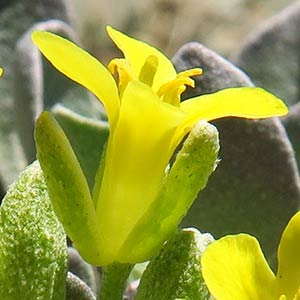|
Devils Gate twinpod
|
alpine twin-pod, Washington bladder-pod, Washington twin-pod
|
| Perennials; caudex usually simple; densely pubescent, trichomes (sessile), rays often furcate, fused toward base, (nearly smooth). |
Perennials; caudex usually simple, rarely branched, (cespitose); (silvery) pubescent throughout, trichomes several-rayed, rays (1- or) 2-bifurcate, (low-umbonate, tubercles relatively few, small). |
simple from base, prostrate, (arising lateral to rosette), 0.1–0.5 dm. |
several from base, decumbent to ascending, (unbranched), 0.5–1.5 dm. |
blade suborbicular, (1–)2.5(–3) cm, (base abruptly narrowed to petiole), margins entire, (flat), (surfaces densely silvery pubescent, trichomes in multiple layers, appressed). |
(petiole slender); blade obovate, 3–5 cm (width 10–20 mm, base tapering abruptly to petiole), margins entire, (apex rarely slightly acute). |
(2–4); blade oblanceolate, ca. 1 cm, (base cuneate), margins entire, (apex acute). |
blade oblanceolate, 0.5–1.5 cm (width 3–5 mm), margins entire. |
condensed. |
subcorymbose. |
sepals (erect, purplish to greenish), linear-oblong or boat-shaped, 5.5–6.5 mm, (lateral pair more saccate than median); petals (white), spatulate, 9–12 mm, (claw undifferentiated from blade). |
sepals oblong, 8–10 mm; petals spatulate, 12–14 mm. |
(divaricate-ascending, nearly straight), 6–10 mm. |
(divaricate, straight), 5–10 mm. |
strongly didymous, irregular in shape and size, (base slightly cordate, apex with a deep closed sinus), strongly to somewhat inflated, 6–8 × 6–8 mm (± bladderlike, papery); valves (retaining seeds after dehiscence), pubescent; replum elliptic to obovate, not constricted, as wide as or wider than fruit, apex obtuse; ovules 4–8 per ovary; style 4–5 mm, (sparsely pubescent or glabrous). |
didymous, mostly highly inflated (strongly flattened at least in 1/2 toward replum), 14–18 × 14–18 mm, (papery, basal sinus slightly notched, apical open, shallow); valves (retaining seeds after dehiscence), evenly pubescent; replum lanceolate, 7–10 mm, width 1.5–2.5 mm, as wide as or wider than fruit, apex acute to acuminate; ovules 8–10 per ovary; style 5–7 mm. |
plump. |
flattened, (2–3 mm). |
|
= 48–52, 52, 64, 67–70. |
|
|
|
|
| Flowering May–Jun. |
Flowering May–Jun. |
| Limestone hills, red soil, rocky calcareous slopes, clay depressions, granite and marble detritus |
Alpine scree, rocky ridges, talus slopes, volcanic sands and gravel, serpentine gravel, granitic slopes, mountain shrub, subalpine fir, and whitebark pine communities |
| 1800-3000 m (5900-9800 ft) |
(700-)1300-2400 m ((2300-)4300-7900 ft) |
|
WY |
WA
|
| FNA vol. 7, p. 635. |
FNA vol. 7, p. 624. |
| Brassicaceae > tribe Physarieae > Physaria |
Brassicaceae > tribe Physarieae > Physaria |
P. acutifolia, P. alpestris, P. alpina, P. angustifolia, P. arctica, P. arenosa, P. argyraea, P. arizonica, P. aurea, P. bellii, P. brassicoides, P. calcicola, P. calderi, P. carinata, P. chambersii, P. cinerea, P. condensata, P. congesta, P. cordiformis, P. curvipes, P. densiflora, P. didymocarpa, P. dornii, P. douglasii, P. engelmannii, P. eriocarpa, P. fendleri, P. filiformis, P. floribunda, P. fremontii, P. garrettii, P. geyeri, P. globosa, P. gooddingii, P. gordonii, P. gracilis, P. grahamii, P. hemiphysaria, P. hitchcockii, P. humilis, P. integrifolia, P. intermedia, P. kingii, P. klausii, P. lata, P. lepidota, P. lesicii, P. lindheimeri, P. ludoviciana, P. macrocarpa, P. mcvaughiana, P. montana, P. multiceps, P. navajoensis, P. nelsonii, P. newberryi, P. obcordata, P. obdeltata, P. occidentalis, P. oregona, P. ovalifolia, P. pachyphylla, P. pallida, P. parviflora, P. parvula, P. pendula, P. pinetorum, P. prostrata, P. pruinosa, P. pulvinata, P. purpurea, P. pycnantha, P. rectipes, P. recurvata, P. reediana, P. rollinsii, P. saximontana, P. scrotiformis, P. sessilis, P. spatulata, P. subumbellata, P. tenella, P. thamnophila, P. tumulosa, P. valida, P. vicina, P. vitulifera |
P. acutifolia, P. alpina, P. angustifolia, P. arctica, P. arenosa, P. argyraea, P. arizonica, P. aurea, P. bellii, P. brassicoides, P. calcicola, P. calderi, P. carinata, P. chambersii, P. cinerea, P. condensata, P. congesta, P. cordiformis, P. curvipes, P. densiflora, P. didymocarpa, P. dornii, P. douglasii, P. eburniflora, P. engelmannii, P. eriocarpa, P. fendleri, P. filiformis, P. floribunda, P. fremontii, P. garrettii, P. geyeri, P. globosa, P. gooddingii, P. gordonii, P. gracilis, P. grahamii, P. hemiphysaria, P. hitchcockii, P. humilis, P. integrifolia, P. intermedia, P. kingii, P. klausii, P. lata, P. lepidota, P. lesicii, P. lindheimeri, P. ludoviciana, P. macrocarpa, P. mcvaughiana, P. montana, P. multiceps, P. navajoensis, P. nelsonii, P. newberryi, P. obcordata, P. obdeltata, P. occidentalis, P. oregona, P. ovalifolia, P. pachyphylla, P. pallida, P. parviflora, P. parvula, P. pendula, P. pinetorum, P. prostrata, P. pruinosa, P. pulvinata, P. purpurea, P. pycnantha, P. rectipes, P. recurvata, P. reediana, P. rollinsii, P. saximontana, P. scrotiformis, P. sessilis, P. spatulata, P. subumbellata, P. tenella, P. thamnophila, P. tumulosa, P. valida, P. vicina, P. vitulifera |
|
Lesquerella alpestris |
| Rollins: Brittonia 33: 333. (1981) |
Suksdorf: W. Amer. Sci. 15: 58. (1906) |
| |
